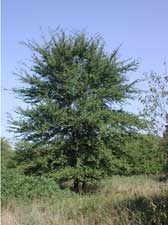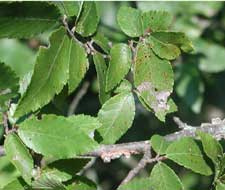Resource Library
Plant of the Week: Winged Elm
The University of Arkansas System Division of Agriculture does not promote, support or recommend plants featured in "Plant of the Week." Please consult your local Extension office for plants suitable for your region.
Plant of the Week
Winged Elm
Latin: Ulmus alata

Elms surround us at every turn here in Arkansas, but they remain in the periphery of our vision and consciousness. One of these, the winged elm, is easy to separate from the others and has considerable merit as a shade tree but is seldom seen in planned landscapes.
Winged elm, Ulmus alatus, is the smallest of our native elms, probably because it has a preference for dry, rocky hillsides or along the margins of eroded ravines where it seldom gets more than 40 feet tall. But, given enough time and protected from the bight of the chainsaw, can attain 65 feet or more in better sites. It ranges throughout the southern states as far north as the Missouri Ozarks.
Winged elm has an erect crown with an oval form, often with stray branches protruding from the regularity of the crown like so many wild hairs. I've never seen one splay out in the wide umbrella-shaped form of the larger American elm.
The most characteristic feature of this elm is the pair of opposite corky outgrowths produced on twigs and small limbs. These corky wings may be as much as one-half inch wide. The name "alata" or "alatus" is fairly common as a species epitaph in botanical names and always refers to some type of wing.
Winged elm leaves are 1½ to 2 inches long, narrow and thick-textured. On dry, difficult sites they can develop yellow or orange fall color. Its greenish to reddish flowers appear in late February with the round, wafer-shaped seeds following in May.

Elms have hard, difficult-to-split wood. This toughness made it ideal for use during the age when farm implements, wagon wheel hubs and even auto chasses contained a fair amount of wood. Because it ranged across the Old South where cotton was king, the inner bark of the tree was often stripped and twisted into cordage for wrapping cotton bales. Today, it's largely ignored in the timber industry except for pallets and other low value uses.
Winged elm is in the landscape trade in the Dallas and Oklahoma City market, but I've never seen it for sale in Arkansas nurseries. Such is the curse of being common. Shunning locally native trees is common except for the glamour species - redbuds, dogwoods, oaks and maples.
The winter form of this tree is interesting, especially on a cloudy, damp day. With its wide wings soaked by wintertime mist, it provides a bold and brooding profile against the gray sky of winter. Only one selection seems to be available in the nursery trade, a mounded weeper called ‘Lace Parasol' that grows to 20 feet tall.
Winged elm is not without its flaws. In moist, lowland sites, it can develop powdery mildew. It's susceptible to Dutch elm disease under cases of artificial infection; however, it doesn't seem to be too susceptible under real world conditions. But it's generally a tough, drought resistant small tree that is a good choice for parking lots or other difficult areas.
By: Gerald Klingaman, retired
Extension Horticulturist - Ornamentals
Extension News - November 10, 2006
The University of Arkansas System Division of Agriculture does not maintain lists of retail outlets where these plants can be purchased. Please check your local nursery or other retail outlets to ask about the availability of these plants for your growing area.